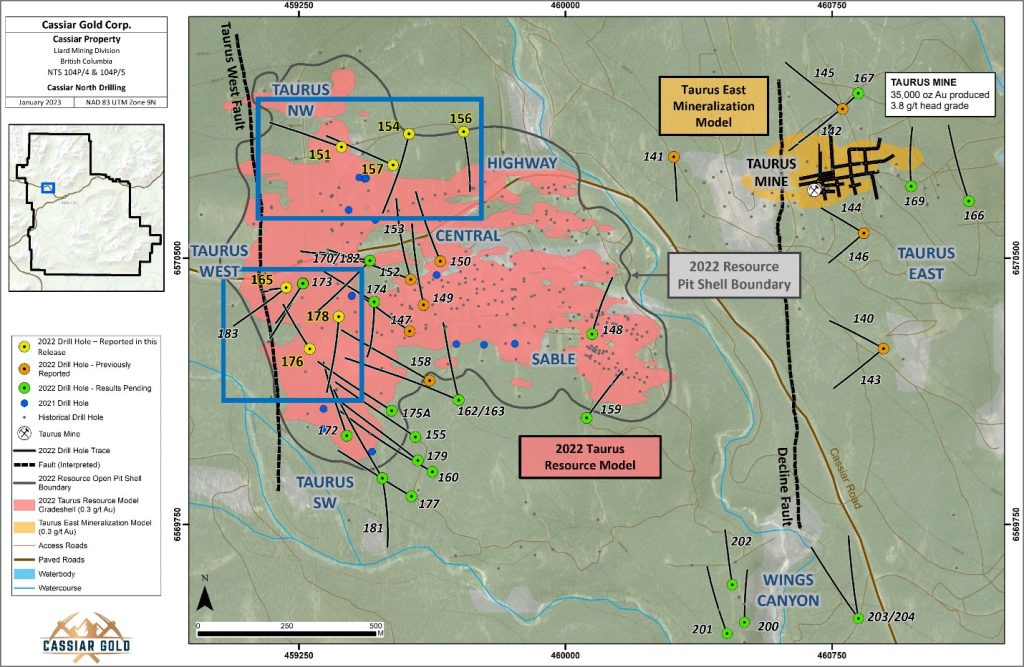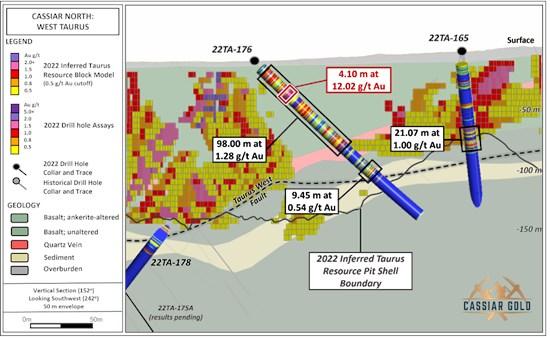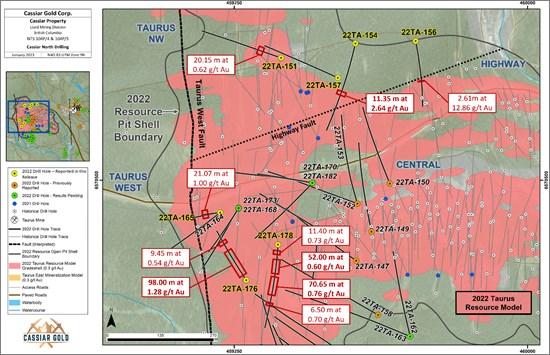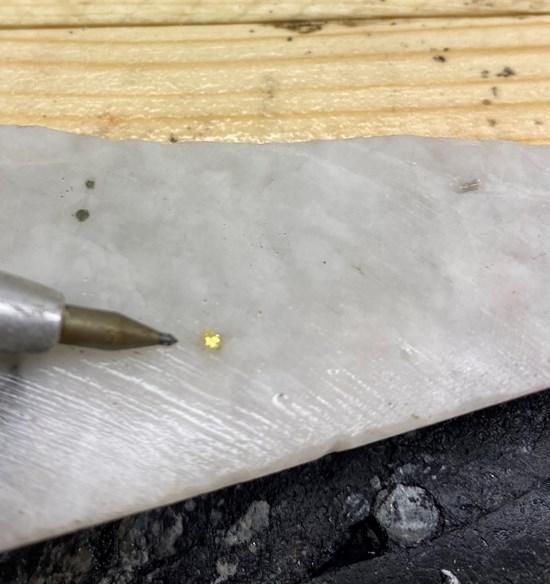
CASSIAR GOLD EXPANDS MINERALIZATION AT THE TAURUS DEPOSIT NEAR-SURFACE AND AT DEPTH INTERSECTING 98.0M OF 1.28 G/T AU AND 70.7M OF 0.76 G/T AU

Cassiar Gold Corp. (TSX-V: GLDC) (OTCQX: CGLCF) is pleased to announce assay results from an additional seven diamond drill holes from the 2022 exploration program completed at the Taurus Deposit, located in the Cassiar North area of the Company’s flagship Cassiar Gold Property in Northern British Columbia, Canada. The Company’s 2022 program included 70 drill holes and over 23,000 m of diamond drilling that began in June and ended in October 2022. The exploration objective focused on high-priority areas of the Taurus Deposit, important vein prospects at Cassiar South and other brownfields opportunities on the property. Cassiar Gold continues to concentrate its efforts on advancing exploration of the project through the expansion and definition of known areas of mineralization as well as the evaluation for the potential of new discoveries on its large land position which contains numerous gold prospects that have had limited historical testing. The results reported here further outline additional areas of mineralization that expand the deposit footprint beyond the limits of the 2022 Inferred resource estimate1 and further define mineralization continuity in the west and northwest areas of the Taurus Deposit. The deposit remains open in all lateral directions as well as at depth.
Highlights from the Taurus West and Taurus Northwest areas:
- Taurus West drill hole 22TA-176 intersected 00 m of 1.28 g/t Au from 10.7 m downhole, including 4.10 m grading 12.02 g/t Au, and expanding mineralization within a large under-explored area between resource blocks within the 2022 inferred mineral resource open pit shell.
- Drill hole 22TA-178 in the Taurus West area returned multiple intervals of gold mineralization, extending mineralization between resource blocks. Intercepts include:
- 0 m of 0.60 g/t Aufrom 51.4 m downhole, and
- 7 m of 0.76 g/t Aufrom 116.0 m downhole, including 7.6 m of 2.02 g/t Au
- All four drill holes completed at Taurus Northwest area (holes 22TA-154, 22TA-151, 22TA-156 and 22TA-157) encountered multi-metre intercepts above the resource cut-off grade. These include:
- 4 m grading 2.64 g/t Au, which extends the distribution of mineralization 20 m beyond the extent of the 2022 resource open pit shell and 40m beyond the extent of the block model.
- A high-grade interval of 86 g/t Au over 2.61 min drill hole 22TA-156, which is open along the northern margin of the known footprint of the deposit.
“Drilling at the Taurus Deposit continues to yield very encouraging results, with Taurus West emerging as a more continuous trend of near-surface mineralization than previously modeled. We are seeing substantial thicknesses and grades well above the cut-off of the 2022 Taurus Deposit resource estimate,” stated Marco Roque, CEO of Cassiar Gold Corp. “We believe that Taurus West has the potential to be a major contributor to Cassiar Gold Corp’s growth and success in the coming years.”
2022 Drilling at the Taurus Deposit – Cassiar North Drill Program
The Taurus Deposit hosts a substantial near-surface, bulk-tonnage inferred gold resource of 1.4 million ounces grading 1.14 g/t Au2. Results from 50 drill holes which cumulatively total 17,140 metres of drilling from the 2022 program are yet to be disclosed and will be made public in future updates. The results reported in this news release are from seven drill holes totaling 1,962 m from the Taurus West and Northwest area of the deposit (Figure 1). They were designed to test the potential for extending known mineralization through step-out drilling and to evaluate the continuity of mineralization between resource blocks. Geologically, the holes were designed to target the different mineralization styles which characterize the Taurus Deposit. These include east-west trending sheeted vein sets, minor shear zones forming bulk-tonnage style mineralization in quartz shear and extension veins sets with coalescing pyrite envelopes, as well as north-northwest trending, east-dipping disseminated pyrite mineralization at depth along the Taurus West Fault. The program has continued to increase the confidence in mineralization distribution within areas of widely spaced historical drilling and collect additional structural data to enhance the geological model. The deposit remains open in all lateral directions as well as at depth.
Drilling in the Taurus deposit continues to demonstrate consistency of grade and apparent thickness of near-surface mineralization above the inferred mineral resource 0.5 g/t Au cut-off, including over broad intervals proximal to the Taurus West Fault. These results highlight the potential to identify additional higher-grade corridors within the 2022 resource open pit shell model. Within broader mineralized intercepts, narrower higher-grade sections (up to >10.0 g/t) are commonly encountered in the Taurus drilling, often associated with quartz veins with or without visible gold, providing the potential for establishing smaller internal zones of high-grade mineralization.

Figure 1. Cassiar North 2022 drill campaign drill hole locations plan map of infill and expansion drilling at the Taurus deposit (blue squares). Drill hole numbers refer to holes with the prefix “22TA-“. Drill holes reported in this news release are shown with yellow collars, pending 2022 drill holes for which complete assays have not yet been received are in green, and previously reported 2022 drill holes are in orange.
Notes – Historical production figures from Taurus MINFILE Production Detail Report, file number 104P 012, BC Geological Survey. The Taurus East mineralization model (orange) represents upside for expansion of the deposit and was not included in the 2022 Taurus resource model (pink).
Taurus West – Drill Holes 22TA-176, 22TA-178, and 22TA-165
Drill hole 22TA-176:
Drill hole 22TA-176 (northwest oriented) was designed to evaluate the continuity of a south-plunging mineralized trend along the Taurus West Fault and to increase near-surface mineralization in an area that had not been previously explored. This drill hole was also extended below the Taurus West Fault to assess potential for mineralization in its footwall. Multiple intercepts were returned (Figure 2, 3; Table 1), that include:
- 98.0 m of 1.28 g/t Au from 10.7 m downhole in near-surface mineralization beyond the boundary of the 2022 resource block model, confirming continuity of mineralization within an 80-200m area of limited exploration. This interval includes a high-grade subinterval of 4.10 m grading 12.02 g/t Au, from 93.0 m downhole and is characterized by ankerite-sericite altered basalt with 10% quartz veining and 5% coarse grained pyritohedrons.
- 9.5 m of 0.54 g/t Au from 134.0 m downhole, occurring in the hangingwall of the Taurus West Fault.

Figure 2. Vertical section showing 22TA-176 at the Taurus Deposit, looking southwest with the 2022 Taurus Resource Block Model for reference.
The drill hole infills a large gap in the block model and suggests mineralization continuity between the earlier widely spaced drill holes. Section width +- 25m.
Drill hole 22TA-178:
This south-southwest oriented drill hole was designed to test the continuity of mineralization along the interpreted Taurus West Fault. The drill hole tested an area which was 65 m away from the closest resource block and 130 m from historical drilling. A shallow, broad mineralized intercept was encountered 170 m and 210 m north of intercepts encountered in 2021 drill holes 21TA-138 and 21TA-137, respectively (see News Release, January 12, 2022).
Results include (Figure 2; Table 1):
- 52.0 m of 0.60 g/t Au from 51.4 m downhole, infilling an area 65 m away from the closest resource block within the 2022 resource open pit shell. This includes a high-grade interval of 0.69 m grading 14.85 g/t Au from 93.0 m.
- 11.4 m of 0.73 g/t Au from 19.2 m downhole and 70.7 m of 0.76 g/t Au from 116.0 m downhole. These results confirm that the distribution of mineralization is consistent with the 2022 block model, both near the surface and at moderate depths, and that mineralization extends beyond the boundaries of the block model.

Figure 3. Plan map of 2022 drill holes reported in this release from the Taurus Deposit. The vertical projection of the mineralized intercepts which are reported here are included for reference.
Drill hole 22TA-165:
Drill hole 22TA-165 (south-southwest oriented) was designed to test the area between the margin of the resource block model and the Taurus West Fault (Figure 3). The drill hole was extended to evaluate the geology in the footwall of the Taurus West Fault. Drilling successfully expanded mineralization with grades above that of the resource estimate in an intercept of 21.1 m grading 1.00 g/t Au (Table 1), which extends mineralization 15 m beyond the limits of the resource pit shell in the hangingwall of the Taurus West Fault.
Drill holes in much of the Taurus West area remain widely spaced and there is future potential to further expand the resource base internal to the deposit area by infilling gaps in the block model where drill holes were too far apart to establish continuity, as is illustrated by drill hole 22TA-176 (Figure 2).
Taurus Northwest – Drill holes 22TA-154, 22TA-151, 22TA-156 and 22TA-157
Drill hole 22TA-154:
Drill hole 22TA-154 (south-southwest oriented) was designed to evaluate the down-dip extension of a steeply dipping east-west mineralized trend near the Highway target (Figure 1,3) and to test for an extension of the interpreted, steeply north-dipping Highway Fault intersected in 2021 drill holes in the Taurus Northwest area (Figure 3). The drill hole encountered a ductile shear/fault in altered basalt with minor quartz veining forming a discrete planar structure marking the boundary of gold and sulphide mineralization in the hangingwall along the interpreted Highway Fault. Results returned include:
- 11.4 m at 2.64 g/t Au from 201.3m downhole, including 4.3m at 3.82 g/t Au, extending mineralization 40m beyond the northern limits of the 2022 resource block model and 20m beyond the open pit shell model.
This drill hole underscores the exploration potential along open extensions of mineralized northeast-trending structures outside the known footprint of the deposit (Figure 3).
Drill holes 22TA-151, 22TA-156 and 22TA-157:
All three of these drill holes intersected mineralization at grades higher than the 0.5 g/t Au cutoff grade of the 2022 inferred mineral resource model (Table 1, Figure 3), including:
- Drill hole 22TA-151 intersected 20.2 m at 0.62 g/t Au from 44.6m downhole.
- Drill hole 22TA-156 intersected 12.86 g/t Au over 2.6 m from 170.4 m drill depth, hosted by altered and pyrite-mineralized basalt with quartz veining and visible gold (Figure 4), just outside the northern limits of the resource model in an area of little previous drilling.

Figure 4. Visible gold in drill hole 22TA-156, observed in a quartz vein hosted in ankerite-sericite altered and pyrite-mineralized basalt (172.0 m drill depth).
These results provide further validation of the continuity and expansion potential of mineralization within in the Company’s 2022 resource estimate and highlight the extension of mineralization outside the pit shell.
Table 1. Significant 2022 drilling results from Taurus Deposit based on a >0.5 g/t cutoff. While true thickness has not been established, drill holes are designed to cross at high to moderate angles known corridors of mineralization based on orientations of mineralized areas defined by previous drilling and structural data from oriented drill core and outcropping veins.
| Target Area | Drill hole | From | To | Length* | Grade | |
| Taurus West | 22TA-165 | 71.7 | 92.8 | 21.07 m | 1.00 g/t Au | |
| 22TA-176 | 10.7 | 108.7 | 98.00 m | 1.28 g/t Au | ||
| incl. | 41.7 | 45.8 | 4.10 m | 12.02 g/t Au | ||
| with | 43.8 | 45.1 | 1.30 m | 25.87 g/t Au | ||
| incl. | 65.0 | 65.6 | 0.55 m | 17.80 g/t Au | ||
| 134.0 | 143.5 | 9.45 m | 0.54 g/t Au | |||
| 22TA-178 | 19.2 | 30.6 | 11.40 m | 0.73 g/t Au | ||
| 51.4 | 103.4 | 52.00 m | 0.60 g/t Au | |||
| incl. | 93.0 | 93.7 | 0.69 m | 14.85 g/t Au | ||
| 116.0 | 186.6 | 70.65 m | 0.76 g/t Au | |||
| incl. | 153.5 | 161.1 | 7.60 m | 2.02 g/t Au | ||
| 212.6 | 219.1 | 6.50 m | 0.70 g/t Au | |||
| Taurus NW | 22TA-151 | 44.6 | 64.8 | 20.15 m | 0.62 g/t Au | |
| 22TA-154 | 201.3 | 212.7 | 11.35 m | 2.64 g/t Au | ||
| incl. | 208.1 | 212.3 | 4.29 m | 3.82 g/t Au | ||
| 22TA-156 | 170.4 | 173.0 | 2.61 m | 12.86 g/t Au | ||
| incl. | 171.8 | 172.4 | 0.58 m | 44.10 g/t Au | ||
| 22TA-157 | 109.6 | 111.8 | 2.13 m | 0.87 g/t Au | ||
| * Drill core lengths are reported here. True widths for these intervals have not been established | ||||||
Correction & Clarification to News Release issued May 19, 2022
The Company would like to correct and clarify the news release entitled “Cassiar Gold reports remaining 2021 Cassiar South drill results; expands known high-grade mineralization at Bain Vein” issued May 19, 2022.”
The Company identified a data entry error within a historical database where individual assay results relevant to the East Bain Extension target at Cassiar South were recorded as ‘parts per million’ (ppm) rather than ‘parts per billion’ (ppb) and a 0.8 m error in reported core length was noted for one record.
Correct values from Drill hole C91-376 are 0.68 g/t Au from 171.5 m to 176.8 m; and 0.29 g/t Au from 190.8 m to 191.2 m. The Correct value from Drill hole C91-378 is 0.04 g/t Au from 99.9 m to 101.3 m. The Company has initiated a systematic validation program pertaining to historical data entry and has determined that unit errors were isolated. This correction does not change any other information reported in the Press Release or impact any of the disclosure in the Company’s filed NI 43-101 compliant mineral resource estimate for the Cassiar Gold Project.
Qualified Person
The technical information in this news release has been reviewed and approved by Jill Maxwell, P.Geo., Cassiar Gold Corp.’s Exploration Manager, who is a Qualified Person as defined by National Instrument 43-101.
Quality Assurance and Quality Control
The 2022 Cassiar drilling program comprises HQ drill core oriented using the REFLEX ACTIII system. Drill core samples are selected and logged by geologists prior to being cut in half using a diamond cutting saw at a secure facility located in Jade City, British Columbia. Certified gold reference standards and blanks are routinely inserted into the sample stream as part of the Company’s QA/QC program. All samples are delivered to the ALS Global preparation facility in Whitehorse, Yukon, where they are processed, and then shipped to the ALS Global analytical facility in North Vancouver, British Columbia. Samples are analyzed for gold by 50-gram fire assay with finish by atomic absorption or gravimetric methods. Screen metallic analysis is performed on selected samples. ALS Global quality systems and technical aspects conform to requirements of ISO/IEC Standard 17025 guidelines.
About Cassiar Gold Corp.
Cassiar Gold Corp. is a Canadian gold exploration company holding a 100% interest in its flagship Cassiar Gold Property located in British Columbia, Canada. The Cassiar Gold property spans 590 km2 and consists of two main project areas: Cassiar North, which hosts a NI 43-101-compliant inferred resource estimate of 1.4Moz at 1.14 g/t Au (cutoff grade of 0.5 g/t Au) known as the as the Taurus Deposit (see National Instrument 43-101 Technical report on the Cassiar Gold property, April 28, 2022, by S. Zelligan, J. Moors, C. Jolette, posted to SEDAR); and Cassiar South which hosts numerous gold showings, historical workings, and exploration prospects. Historical underground mines in the Cassiar South area have yielded over 315,000 oz of Au at average head grades of between 10 and 20 g/t Au (2017, Cowley3), underscoring the high potential for further discovery and expansion of high-grade orogenic gold veins.
The Company also holds a 100% interest in the Sheep Creek gold camp located near Salmo, BC. The Sheep Creek gold district ranks as the third largest past-producing orogenic gold district in BC with historical gold production of 742,000 ounces gold at an average grade of 14.7 g/t gold from 1900 to 1951. Minimal exploration work has been conducted since the 1950s.
Cassiar Gold Corp. acknowledges, respects, and supports the rights of Traditional First Nations in the lands and communities where we operate.
MORE or "UNCATEGORIZED"
Kuya Silver Confirms High-Grade Silver-Gold Vein Mineralization at Umm-Hadid with Initial Drill Results up to 1483.9 g/t AgEq over 2 Metres
Kuya Silver Corporation (CSE: KUYA) (OTCQB: KUYAF) (FSE: 6MR1) is... READ MORE
First Phosphate Closes Final Tranche of Oversubscribed Private Placement
First Phosphate Corp. (CSE: PHOS) (OTCQX: FRSPF) (FSE: KD0) is... READ MORE
GFG Receives Final Payment from the Sale of its Rattlesnake Hills Gold Project
GFG Resources Inc. (TSX-V: GFG) (OTCQB: GFGSF) announces that i... READ MORE
Goliath Receives $1,730,882 Through Warrant Exercises, Inclusive Of Crescat Capital A Longtime Strategic And Cornerstone Shareholder
Goliath Resources Limited (TSX-V: GOT) (OTCQB: GOTRF) (FSE: B4IF)... READ MORE
Robex Pours First Gold at Kiniéro on Schedule and Budget
Highlights: Gold bar weighing 2.64 kilograms (85 oz) poured in th... READ MORE












